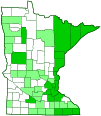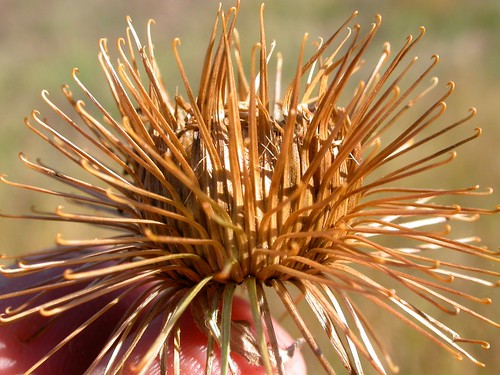great burdock
(Arctium lappa)
Conservation • Description • Habitat • Ecology • Use • Distribution • Taxonomy
Conservation Status |
|
|||||||
| IUCN Red List | not listed |
|||||||
| NatureServe | NNA - Not applicable |
|||||||
| Minnesota | not listed |
|||||||
Description |
||
Great burdock is a 3′ to 9′ tall, but usually 5′ tall or less, erect, biennial forb that rises on a single stem from a fleshy taproot. In its first year of growth this produces a rosette of basal leaves. In the second year it produces a hollow stalk that is branched, hairy, and ridged. Basal leaves are large, heart shaped and indented at the base where they attach to long leaf stalks. They are 10″ to 31″ long and 8″ to 27″ wide. The leaf stalk is 6″ to 14″ long, deeply grooved, and solid. The upper surface is green with sparse short hairs. The lower surface is light green or gray-green, with a thin covering of matted, short, soft, woolly hairs. The leaf margins are wavy. By the time the flowers are fully open the basal leaves are usually withered. Stem leaves are much smaller, alternate, and egg-shaped, getting progressively smaller toward the top of the stem. They are nearly hairless on both the upper and lower surfaces. The inflorescence is a cluster of long-stalked flower heads, the outer ones on longer stalks, forming a flat-topped or convex cluster. The clusters appear at the end of the stem and in the upper leaf axils. They are crowded and densely packed. Flower heads have about 40 purple florets and are on 1″ to 2⅓″ long stalks. The whorl of overlapping bracts subtending the flower head is 1″ to 1½″ in diameter. It is hairless except for, usually, a few long, cobwebby hairs. The bracts are hooked at the tip. When dry the flower head becomes a bur resembling a thistle. Thistles, however, do not have hooked bracts. |
||
Height |
||
3′ to 9′, but usually 5′ or less |
||
Flower Color |
||
Purple |
||
Similar Species |
||
Common burdock (Arctium minus) leaf stalks are hollow, at least at the base, and are not grooved. The flower heads are smaller, ½″ to 1″ in diameter, and are on short stalks or are stalkless. Woolly burdock (Arctium tomentosum) flower heads are densely cobwebby. |
||
Habitat |
||
Disturbed sites, roadsides. |
||
Ecology |
||
Flowering |
||
August to October |
||
Pests and Diseases |
||
|
||
Use |
||
|
||
Distribution |
||||
|
Sources Almost all sources show great burdock uncommon in Minnesota, mostly restricted to the easternmost counties and the Metro Region. iNaturalist, which relies on citizen science, shows the species much more common and occurring throughout the state. The counties in light green on the map have records only from iNaturalist. |
|||
| 4/28/2023 | ||||
Nativity |
||||
Native to Asia, Europe, and the Indian subcontinent. Introduced and naturalized in the United States. |
||||
Occurrence |
||||
Uncommon in Minnesota |
||||
Taxonomy |
|||
| Kingdom | Plantae (Plants) | ||
| Division | Tracheophyta (Vascular Plants) | ||
| Subdivision | Spermatophytina (Seed Plants) | ||
| Class | Magnoliopsida (Dicots) | ||
Order |
Asterales (Sunflowers, Bellflowers, Fanflowers, and Allies) | ||
Family |
Asteraceae (Sunflowers, Daisies, Asters, and Allies) | ||
| Subfamily | Carduoideae (thistles and allies) | ||
| Tribe | Cardueae | ||
| Subtribe | Carduinae (thistles and burdocks) | ||
| Genus | Arctium (burdocks) | ||
Cardueae is a synonym of the tribe name. Cynareae was published first and has precedence. Nevertheless, most sources use the name Cardueae for the tribe. |
|||
Subordinate Taxa |
|||
|
|||
Synonyms |
|||
Arctium chaorum Arctium lappa ssp. majus Arctium leiospermum Arctium majus Lappa major Lappa vulgaris |
|||
Common Names |
|||
beggar’s-button burdock cockle-button cuckold edible burrdock giant burdock gobo great burdock greater burdock harlock |
|||
Glossary
Axil
The upper angle where the leaf stalk meets the stem.
Bract
Modified leaf at the base of a flower stalk, flower cluster, or inflorescence.
Visitor Photos |
|||||
Share your photo of this plant. |
|||||
| This button not working for you? Simply email us at info@MinnesotaSeasons.com. Attach one or more photos and, if you like, a caption. |
|||||
|
|||||
MinnesotaSeasons.com Photos |
|||||
|
|||||


Visitor Videos |
|||
Share your video of this plant. |
|||
| This button not working for you? Simply email us at info@MinnesotaSeasons.com. Attach a video, a YouTube link, or a cloud storage link. |
|||
Other Videos |
|||
| Greater burdock (Arctium lappa) - 2013-07-22 W3stlander |
|||
About
Published on Aug 8, 2013 Arctium lappa, commonly called greater burdock, gobō,edible burdock, lappa, or beggar's buttons, is a biennial plant[citation needed] of the Arctium (burdock) genus in the Asteraceae family, cultivated in gardens for its root used as a vegetable. It is an invasive weed of high-nitrogen soils. -------------- |
|||
| Greater Burdock (Arctium Lappa) - 2012-08-14 W3stlander |
|||
About
Published on Aug 21, 2012 Arctium lappa, commonly called greater burdock, edible burdock, lappa, or beggar's buttons, is a biennial plant of the Arctium (burdock) genus in the Asteraceae family, cultivated in gardens for its root used as a vegetable. It is an invasive weed of high-nitrogen soils. -------------- |
|||
| Wild plant food journey's #9 Burdocks. Arctium lappa / A.minor MP4 ipso phyto |
|||
About
Published on Oct 31, 2012 Autumn is the best time for gathering wild rots. Here, experienced forager and medicinal plantsman Christopher Hope BSc describes the very common, yet underused burdocks. A fantastic food for diabetics as it contains inulin, not starch. This plant is much used medicinally as well as an alterative. Available most everywhere and difficult not to find! For more information and foraging courses all yea round, visit www.ipsophyto.com |
|||

Visitor Sightings |
|||||
Report a sighting of this plant. |
|||||
| This button not working for you? Simply email us at info@MinnesotaSeasons.com. Be sure to include a location. |
|||||
|
|||||
MinnesotaSeasons.com Sightings |
|||||

|
Created: Last Updated: © MinnesotaSeasons.com. All rights reserved. |

